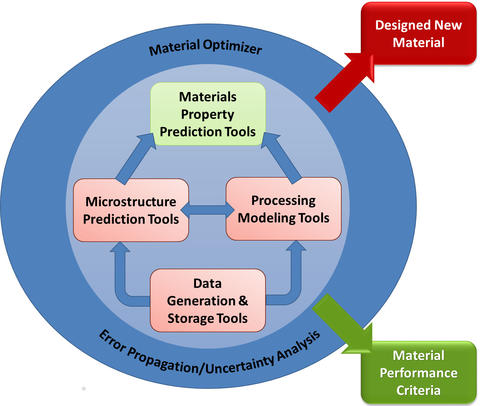Summary
The Materials Genome Initiative (MGI) creates a new era of materials innovation that will serve as a foundation for strengthening domestic industries in these fields. This initiative offers a unique opportunity for the United States to discover, develop, manufacture, and deploy advanced materials at least twice as fast as possible today, at a fraction of the cost. Essential to this effort is the development of a data infrastructure that will provide the needed data and tools to support this effort.
An essential part of the MGI is development of a repository for phase-based data to support the development of CALPHAD type databases. CALPHAD databases represent phase-based property data, such as the Gibbs energy, as functions of composition, temperature and pressure and have been essential tools in developing new materials and processes. Multicomponent databases are constructed by combining unary, binary, and ternary descriptions to extrapolate to multicomponent systems (n >3). These CALPHAD databases rely on both experimental and computational phase-based data including, thermodynamic, diffusion, molar volume, elastic property, electrical conductivity, or thermal conductivity data. These data are diverse, semi-structured and often have incomplete descriptions of their provenance.
Another challenge is that different users of the data have different needs. For example, a user from industry may just want a number (e.g. the diffusion coefficient for specific material) while an expert in the field may want all the available raw data, e.g., in addition to the reported diffusion coefficients and composition profiles this user also wants the original measurement data, such as SIMS intensity vs. distance data (if SIMS was used to collect the diffusion data.). This requires that a data infrastructure be built to accommodate a variety of user needs as well as data types.
Description

The NIST Phase-base data repository will consist of three sources:
- Curated experimental literature from the Thermodynamic Research Center (http://trc.nist.gov/metals_data/)
- Experimental and computational curated using the NIST Materials Data Curation System are avaialble at (https://mdcs1.nist.gov)
- Experimental and calculated self-diffusion data at http://www.ctcms.nist.gov/~gkl/selfdiffusion.html
Database files from published CALPHAD assessments are availalbe via the NIST MaterialsData Repository in the CALPHAD Assessments collection.
Major Accomplishments
- NIST/CHiMaD CALPHAD Data Workshop to determine data needs for CALPHAD assessments. May 2015
- XML schemas tracer and interdiffusion data have been proposed and are available the MDCS-Community Gitbub repository (https://github.com/MDCS-community/modular-data-models-include)
Links to recent publications
- "The development of phase-based property data using the CALPHAD method and infrastructure needs" DOI: 10.1186/2193-9772-3-12(link is external)
- "An Informatics Infrastructure for the Materials Genome Initiative" DOI:10.1007/s11837-016-2000-4(link is external)
Data Informatics and Tools for Phase-Based Property Data presentation from 2nd World Congress on ICME, Salt Lake City, July 9, 2013.

